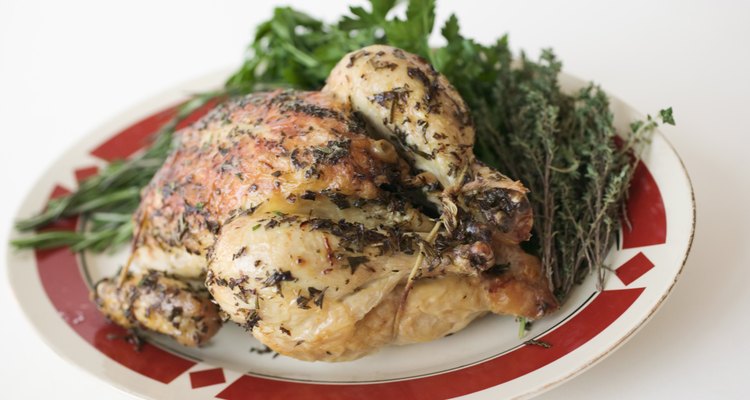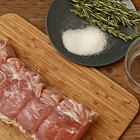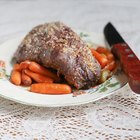
Brining, the process of soaking meat in a salty solution, makes chicken moist and tender. Although brining prepares your chicken for a number of different cooking methods, it's just a preliminary step to cooking, not a replacement. The USDA recommends cooking chicken to an internal temperature of 165 degrees Fahrenheit to ensure its safety for your family; that goes for brined meats as well.
The Chemistry of Brining
Brining uses science to produce a tastier bird. As the chicken brines, osmosis first moves water from the meat into the solution as salt and sugar migrate into the meat via diffusion. After a few hours, the salt in the meat draws flavorful brining solution back into the poultry, making it juicier. As the solution replaces some of the fluid in the meat, brining performs the biochemical equivalent of redecorating a room. It takes out the blandness and adds concentrated flavor.
How to Brine
Choose a container large enough to keep the entire chicken fully submerged in brining liquid. Use a prepared brining mixture or make your own basic version from salt, sugar and water. Prepared brines have the advantage of measuring the right amounts of sugar and salt for you. If you make your own brine, try different spice mixtures to vary the formula. A package of dried prepared salad dressing or dip mix, or a handful of peppercorns and bay leaves in the brine adds a subtle flavor to the meat after the bird cooks.
Food Safety
Even the cleanest raw poultry can harbor microbes, so keep the brining liquid confined to a bin or pot that won't leak in your refrigerator. Take a tip from chefs and keep raw chicken on the bottom shelf as it brines; that way a leak or spill can't drip onto lower shelves and spread raw chicken juices to other foods. Dispose of the brine once you've soaked your chicken in it; unlike cooked stocks and broths, used brine contains raw juices.
Cooking Brined Chicken
Brining adds water, so dry cooking methods will leave your chicken dinner succulent and juicy. Roasting and brining go especially well together; if you've ever tasted a dry chicken, you'll appreciate the importance of a juicy bird. Grilling also lends itself to brined chicken. You can combine brining and marinating for barbecues, too. Brine first, then pat the chicken dry and marinate it for an hour or two to get a second layer of flavor. You don't need to cook the chicken immediately after removing it from the brine. Then grill and baste with your favorite flavorful sauce.
Related Articles

How to Smoke a Chicken in the Oven

How to Make Salt Brine

How to Marinate Roast Chicken

How to Tie a Rotisserie Chicken

Does Packaged Chicken Have to Be Washed ...

How to Brine Pork Roast

Can You Cold Smoke Chicken?

How to Brine a Turkey Using Orange Juice

How to Make a Brine for Quail

Can I Start Marinating While My Chicken ...

The Best Way to Smoke Yellowtail

How to Bake Great Chicken Legs and Wings

How to Make Marinade for Roast Beef

How to Defrost a Chicken in a ...

How to Cook Chicken Legs With Italian ...

How to Soak Chicken in Cold Water

Blanching Chicken Before Grilling

How to Make Crock-pot Chicken

How to Brine a Pheasant

How to Cook Boneless Chicken Breasts to ...
References
Writer Bio
Lauren Whitney covers science, health, fitness, fashion, food and weight loss. She has been writing professionally since 2009 and teaches hatha yoga in a home studio. Whitney holds bachelor's degrees in English and biology from the University of New Orleans.
Photo Credits
Creatas/Creatas/Getty Images